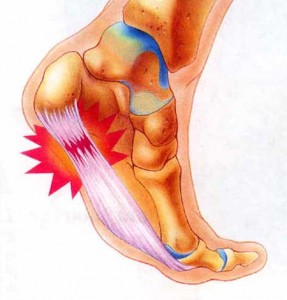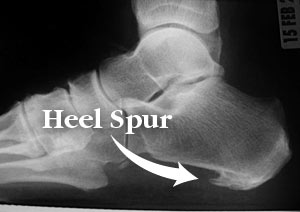 The plantar fascia is a thick, connective tissue that runs from the heel to the ball of the foot. It helps to maintain the arch of the foot and is also one of the major transmitters of weight across the foot as you walk or run.
The plantar fascia is a thick, connective tissue that runs from the heel to the ball of the foot. It helps to maintain the arch of the foot and is also one of the major transmitters of weight across the foot as you walk or run.
 Plantar Fasciitis is an inflammation of this area of the foot where tightness in this tissue begins to pull it from its connection at the heel. This often results in a bone spur as a calcification begins to form at the spot where the fascia is being pulled away. In an x-ray of this type of foot you will see what looks like a spur of bone making up for the shortening of the planar fascia. Plantar fasciitis symptoms are usually limited to the heel though sometimes involve the front of the foot as well.
Plantar Fasciitis is an inflammation of this area of the foot where tightness in this tissue begins to pull it from its connection at the heel. This often results in a bone spur as a calcification begins to form at the spot where the fascia is being pulled away. In an x-ray of this type of foot you will see what looks like a spur of bone making up for the shortening of the planar fascia. Plantar fasciitis symptoms are usually limited to the heel though sometimes involve the front of the foot as well.
There are many causes attributed to this plantar fasciitis— too much activity, arthritis, diabetes, poor shoes, and others. Poor body mechanics are often listed last in the list. From our perspective this should be at the top of the chart as we believe that poor posture and gait are the main contributing factor for this troubling injury.
Plantar fasciitis symptoms typically worsen early in the morning after sleep. Your first steps after waking can feel as if you are walking on shards of glass. Over the course of the night the plantar fascia has pulled off of the sole of the foot, tightening and drawing the toes in towards the heel. As you begin to walk around and loosen the plantar fascia, the pain usually subsides, but often returns with prolonged standing or walking. One option for relief of an advanced case of plantar fasciitis is to wear a protective boot to sleep which will keep the fascia from contracting and then begin to work on your mechanics and change your movement pattern. But as with many fixes, the boot doesn’t work for everyone.
At CoreWalking we believe that the way you walk, specifically the way your strike your heel with each step— while maybe not the cause of the plantar fasciitis— can exacerbate the pain and make healing more difficult.
